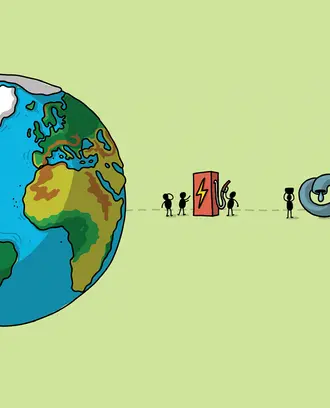Credit: The Image Party / Shutterstock
At a time when some corporations are rolling back their climate pledges, Walmart has a bold goal: The company is targeting zero emissions across its global operations by 2040 and has committed to help protect, manage, or restore 50 million acres of land and 1 million square miles of ocean by 2030.
These initiatives make sense for a massive retailer with an outsize carbon footprint, but smaller companies can learn something from its strategy too.
Vishal Kapadia, senior vice president for energy transformation at Walmart, spoke at the recent 2023 ClimateTech conference, hosted by MIT Technology Review, and offered four takeaways for businesses of any size.
Set and control a clean-energy example
How can your company change minds and influence consumers? Walmart will deploy a fast-charging network for electric vehicles across its stores and Sam’s Clubs, hoping to encourage more customers to buy EVs.
Kapadia said that some potential customers have “range anxiety” — the worry that they won’t be able to find a charger when they need one. He hopes that Walmart’s charging network will help provide reassurance to potential EV buyers, since there’s a Walmart or Sam’s Club within 10 miles of most Americans.
“There are issues around anxiety and customer experience that are really [keeping] a lot of folks from taking that plunge and purchasing an electric vehicle,” Kapadia said. “When you think about [Walmart’s] proximity advantage and how many customers that we can ultimately touch, we’re well suited to address range anxiety in a way that few others are.”
It’s also a new revenue stream for the company, so it’s a win-win.
“We’ll be [shifting] from the model that we’ve deployed today, which is really to have third parties own that infrastructure on our footprint, to a model where we’re going to own and operate that infrastructure,” Kapadia said.
Remember that what’s good for the planet can help operations, too
If fighting climate change seems like a do-good abstraction, consider that it’s also good for supply chain stability.
Climate initiatives are about both value creation and value preservation, Kapadia said. “One of the issues that, as the grid starts to transition, we’re ultimately going to be facing in terms of business continuity [is] that goal of needing to and wanting to be ‘always on’ as a retailer,” he said.
Clearly, Walmart has a strong imperative to reduce emissions — “I would imagine we consumed as much electricity last year as two small countries,” Kapadia admitted — but highlighting value-preserving benefits can help to increase a company’s motivation.
Know that climate initiatives are likely to transform the enterprise
In its quest to be emissions-free, Walmart will focus first on transportation and facilities, where most of its emissions originate. This is difficult, since the Walmart, like most companies, actually needs to continue business as usual while transitioning to lower-emissions processes — in its case, those involving vehicles and refrigerants.
Related Articles
Kapadia likened it to performing open heart surgery on a patient who’s wide awake. It requires alignment, close collaboration, and the ability to pick your battles.
“It’s very much about partnering across our organization and across all of the different functions within our organization. … It requires close collaboration and teamwork with folks across our supply chain teams, our transportation teams, and, ultimately, our operators, who are going to be operating more vehicles. … It’s an exercise where energy transformation really ends up being a function of enterprise transformation,” he said.
To simplify, start with low-hanging fruit. For Walmart, that means electrifying its last-mile delivery vehicles. It’s an area where “the technology is there, and it is addressable and not disruptive to our baseline operations,” Kapadia said.
Incentivize your partners
Naturally, Walmart maintains an enormous supplier web. Its Project Gigaton aims to drive out a billion metric tons of carbon emissions through its supply chain by 2030. Kapadia reported that the company is nearly 75% there. How? Its efforts have involved educating suppliers about the impacts of emissions on operations and society more broadly and on issues around resilience, as well as demonstrating a clear value proposition.
“[Project Gigaton] was really a mechanism for suppliers to be able to be incentivized to report on the types of projects and initiatives that they’re undertaking to push emissions out of their supply chain,” he said. “As we decarbonize our operations, [we’re] creating models and templates that we can utilize to bring to our suppliers that they can go faster, and further, and decarbonize their operations.”
Read next: Tackling climate change with machine learning



